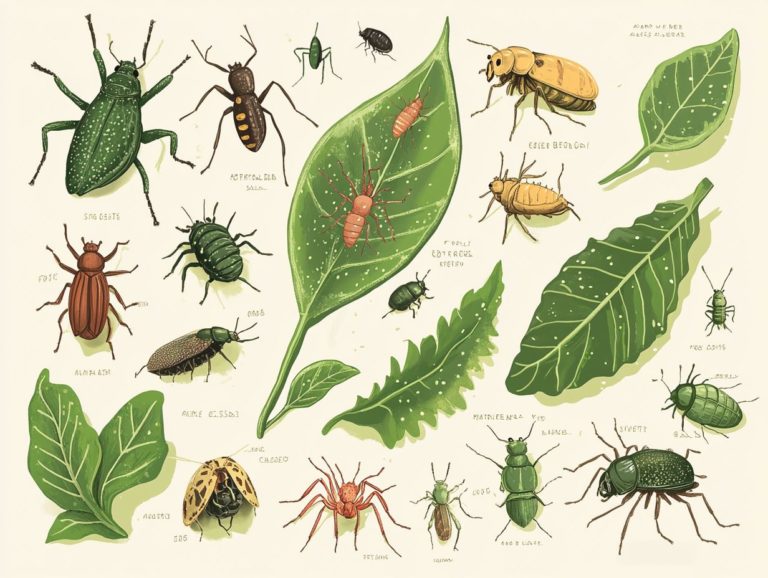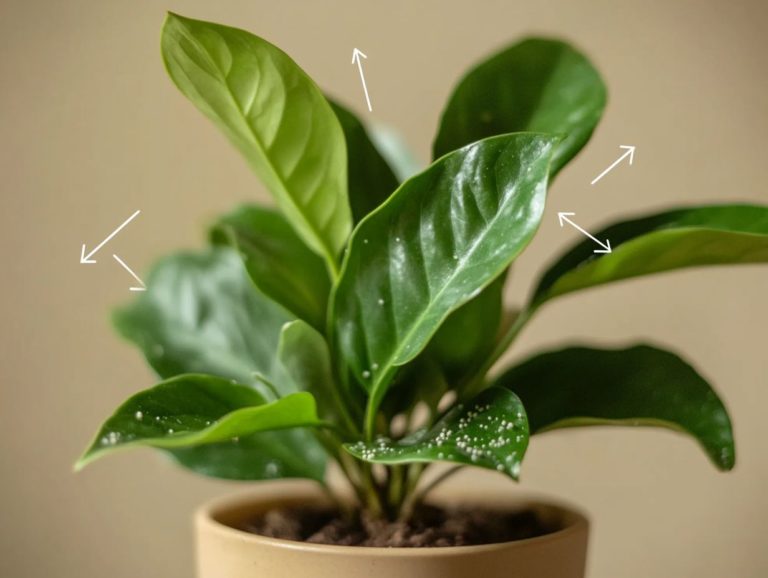How to Create a Pest Control Emergency Plan
In today s landscape, effective pest control is vital, particularly in settings where infestations can present considerable risks.
A well-crafted Pest Control Emergency Plan is essential for protecting your properties and ensuring safety.
This guide delves into what such a plan entails, the advantages it brings, and the essential steps to formulate and execute an effective strategy.
From evaluating potential vulnerabilities to training your staff, you ll discover everything necessary to uphold a pest-free environment and safeguard your valuable assets.
Contents
- Key Takeaways:
- Understanding Pest Control Emergency Planning
- Benefits of Having a Pest Control Emergency Plan
- Steps to Create a Pest Control Emergency Plan
- Implementing and Maintaining the Plan
- Frequently Asked Questions
- What is a pest control emergency plan?
- Why is it important to have a pest control emergency plan?
- How do I create a pest control emergency plan?
- Who should be involved in creating a pest control emergency plan?
- How often should a pest control emergency plan be reviewed and updated?
- What should I do if a pest control emergency occurs?
Key Takeaways:

- A Pest Control Emergency Plan is a proactive and comprehensive approach to minimizing pest infestations and damage in emergencies.
- Having this plan prevents costly infestations and ensures compliance with health and safety regulations.
- To create the plan, assess potential risks, prioritize emergency procedures, and establish communication protocols. Regular maintenance and training are also crucial for effective implementation.
Understanding Pest Control Emergency Planning
Pest control emergency planning is critical for ensuring environmental safety, particularly in areas where pests threaten cultural heritage and building integrity. This plan requires a strategic approach to prepare for potential infestations and their associated risks, guaranteeing prompt pest management.
By incorporating emergency response protocols and guidelines, you can significantly reduce damage and create a secure environment for both staff and visitors.
What is a Pest Control Emergency Plan?
A Pest Control Emergency Plan serves as a detailed plan outlining procedures for addressing pest-related emergencies, such as infestations and chemical spills, ensuring a swift and effective response.
This plan includes essential emergency contact numbers for local pest control services and hazardous material response teams, enabling you to secure prompt assistance whenever issues arise. It also details spill cleanup procedures, providing clear guidance on how to safely handle and contain hazardous substances, minimizing environmental impact and health risks.
Training your staff is crucial; it equips them with the knowledge and skills necessary to act decisively during emergencies. By integrating such protocols into your pest management programs, you can effectively mitigate risks and ensure the safety of employees and the surrounding community.
Benefits of Having a Pest Control Emergency Plan
Creating a Pest Control Emergency Plan brings many benefits! It equips you with effective pest prevention strategies while enhancing the safety of occupants and any cultural heritage organizations involved, especially regarding pest control protocols.
It also ensures compliance with local regulations, safeguarding your interests on multiple fronts.
Preventing Infestations and Damage
Preventing infestations and damage is crucial in keeping pests under control; proactive measures significantly lower the risk of unwelcome visitors like termites, mice, and cockroaches.
To adopt a comprehensive approach, consider establishing physical barriers to keep pests out. This could involve sealing cracks and installing screens to block entry points. Regularly monitoring potential entry areas is essential, so check doors, windows, and vents for vulnerabilities.
Implementing a robust housekeeping program is key to maintaining cleanliness, reducing attractants, and eliminating food sources that pests seek. By routinely organizing and decluttering your space, you create an environment that is far less inviting to unwanted guests, leading to a noticeable decrease in pest activity.
Ensuring Safety and Compliance

Ensuring safety and compliance within pest management protocols is crucial for your business or organization. By adhering to regulations, you not only protect the environment but also safeguard the health of everyone involved.
Implementing comprehensive safety measures, such as using personal protective equipment (PPE), is vital to minimizing risks associated with pesticide application. These protective tools shield your workers from exposure to hazardous substances, promoting a healthier workplace for everyone.
Having spill kits on hand enhances safety, allowing for swift responses to any accidental leaks or spills. Being ready is crucial and can save you from bigger problems later!
Decontamination materials are equally important, providing guidance on effectively managing potential contamination. This ensures regulatory compliance during emergency response situations and fosters a culture of safety and responsibility within the pest control industry.
Steps to Create a Pest Control Emergency Plan
Creating a pest control emergency plan requires careful consideration of several essential steps. Start by assessing potential risks and vulnerabilities. This thorough evaluation ensures that effective procedures are established for managing pests during emergencies.
This proactive approach will not only safeguard your environment but also provide peace of mind in the face of unexpected challenges.
Assessing Potential Risks and Vulnerabilities
Assessing potential risks and vulnerabilities is key to creating a good pest control emergency plan. This process lets you discover exactly what pest threats you face and any environmental factors that could worsen infestations.
By conducting a thorough evaluation of entry points such as cracks in foundations or gaps around windows and doors you can devise strategies to seal these vulnerabilities effectively. Emphasizing environmental controls, such as proper waste management and maintaining tidy surroundings, can significantly reduce the chances of pest proliferation.
Understanding the specific behaviors and seasonal patterns of pests will help you anticipate their movements and potential entry points. Continuous monitoring and regular inspections are essential to ensure that any newly discovered weaknesses are promptly addressed.
This proactive approach leads to a more comprehensive strategy for tackling pest-related challenges.
Identifying and Prioritizing Emergency Procedures
Identifying and prioritizing emergency procedures in pest control is crucial for ensuring that you take the most critical actions swiftly. This effectively mitigates potential pest-related hazards.
This involves establishing clear spill cleanup protocols to manage hazardous substances safely, thereby preventing further environmental contamination. Communication strategies with emergency responders are equally vital. Having ready access to contact information, incident details, and the nature of the pest problem can significantly enhance response efficiency, especially when following guidelines on how to create a pest monitoring plan.
By assembling a designated team trained in emergency response, you can ensure that actions taken during an incident are effective and compliant with health regulations. This ultimately minimizes risks to human health and safeguards environmental safety.
Establishing Communication and Response Protocols
Establishing clear communication and response protocols is essential for successfully implementing a pest control emergency plan. This enables seamless coordination among your staff and emergency responders during a crisis.
Effective communication strategies ensure that everyone involved, from frontline workers to management, understands their roles and responsibilities when unexpected pest-related situations arise. By utilizing designated emergency telephone numbers, you facilitate prompt reporting and response to pest outbreaks, which minimizes potential damage or health risks. Additionally, having a well-prepared indoor pest control kit can further enhance your readiness for such events.
Regular training sessions equip your team with the necessary skills and knowledge to react swiftly and effectively. This reinforces the importance of adhering to established protocols.
By prioritizing these elements, your pest management team can foster a more organized and efficient approach to handling emergencies, ultimately leading to better outcomes for everyone concerned.
Start planning your pest control emergency strategy today for a safer tomorrow!
Implementing and Maintaining the Plan

Implementing and maintaining a Pest Control Emergency Plan is crucial for immediate action in your ongoing pest management efforts. This plan ensures that every staff member is informed and ready to respond promptly in the event of an emergency.
Training and Drills for Employees
Training and drills for employees are vital elements in executing a Pest Control Emergency Plan effectively. They equip your team to respond adeptly to pest emergencies.
By organizing structured training sessions, you ensure that every team member understands their roles and responsibilities during a pest crisis. Techniques like hands-on simulations and real-life practice drills reinforce the protocols laid out in the emergency plan and enhance your team’s readiness.
Regular drills sharpen response times and foster team cohesion, allowing staff to collaborate effortlessly under pressure. Throughout these sessions, the focus is on the proper use of personal protective equipment (PPE) to guarantee safety when handling hazardous materials.
This comprehensive approach nurtures a culture of preparedness, which is crucial for minimizing potential damages caused by pest infestations.
Regular Review and Updates
Conducting regular reviews and updates of your Pest Control Emergency Plan is essential to maintain its effectiveness and relevance in managing pest risks and emergencies. Aim for these reviews at least once a year, or more frequently if you notice significant changes in pest management practices, local regulations, or monitoring data.
Monitoring data is crucial for evaluating your plan s effectiveness. Without it, your adaptations to emerging pest threats may fall short. Staying aligned with updated regulations and best practices enhances your safety and ensures compliance with industry standards.
By revisiting your plan regularly, you can make proactive adjustments that keep your pest control strategies effective and in tune with the latest research and technological advancements in the field.
Frequently Asked Questions
What is a pest control emergency plan?
A pest control emergency plan is a set of guidelines and procedures outlining how to respond to a sudden pest infestation or outbreak effectively. It includes potential risks from various pests like rodents, insects, and other nuisances.
Why is it important to have a pest control emergency plan?

Having a pest control emergency plan in place can minimize the damage and disruption caused by a pest infestation. It also ensures the safety and well-being of individuals in the affected area.
How do I create a pest control emergency plan?
To create a pest control emergency plan, first assess potential pest risks. Develop response protocols and designate roles and responsibilities. Include contact information for pest control professionals and emergency services.
Who should be involved in creating a pest control emergency plan?
Involve key stakeholders such as facility managers, pest control professionals, and safety officers in creating a pest control emergency plan. This ensures that all necessary perspectives and expertise are considered.
How often should a pest control emergency plan be reviewed and updated?
A pest control emergency plan should be reviewed and updated at least once a year. However, review it whenever there are changes in the facility, pest management strategies, or personnel involved in the plan.
What should I do if a pest control emergency occurs?
In the event of a pest control emergency, follow the procedures outlined in the emergency plan. This may include evacuating the affected area, contacting pest control professionals, and implementing pest control measures immediately.
Prepare your plan today to protect your space from unexpected pest emergencies!






